Management Accounting: Costing, Planning, and Financial Analysis
VerifiedAdded on 2020/12/26
|9
|1505
|444
Report
AI Summary
This report provides an executive summary of management accounting techniques, focusing on costing methods like marginal and absorption costing, and their application to Tesco. It explores various planning tools for budgetary control, such as scenario, contingency, and forecasting tools, evaluating their advantages and disadvantages. The report further assesses the implementation of management accounting systems to overcome financial problems, including the use of benchmarking and KPIs, comparing Tesco's approach with Walmart's. The analysis highlights the importance of financial governance in managing financial issues like carting and storage costs, providing recommendations for Tesco to enhance its strategic use of management accounting, supported by appendices with profit calculations and working notes.
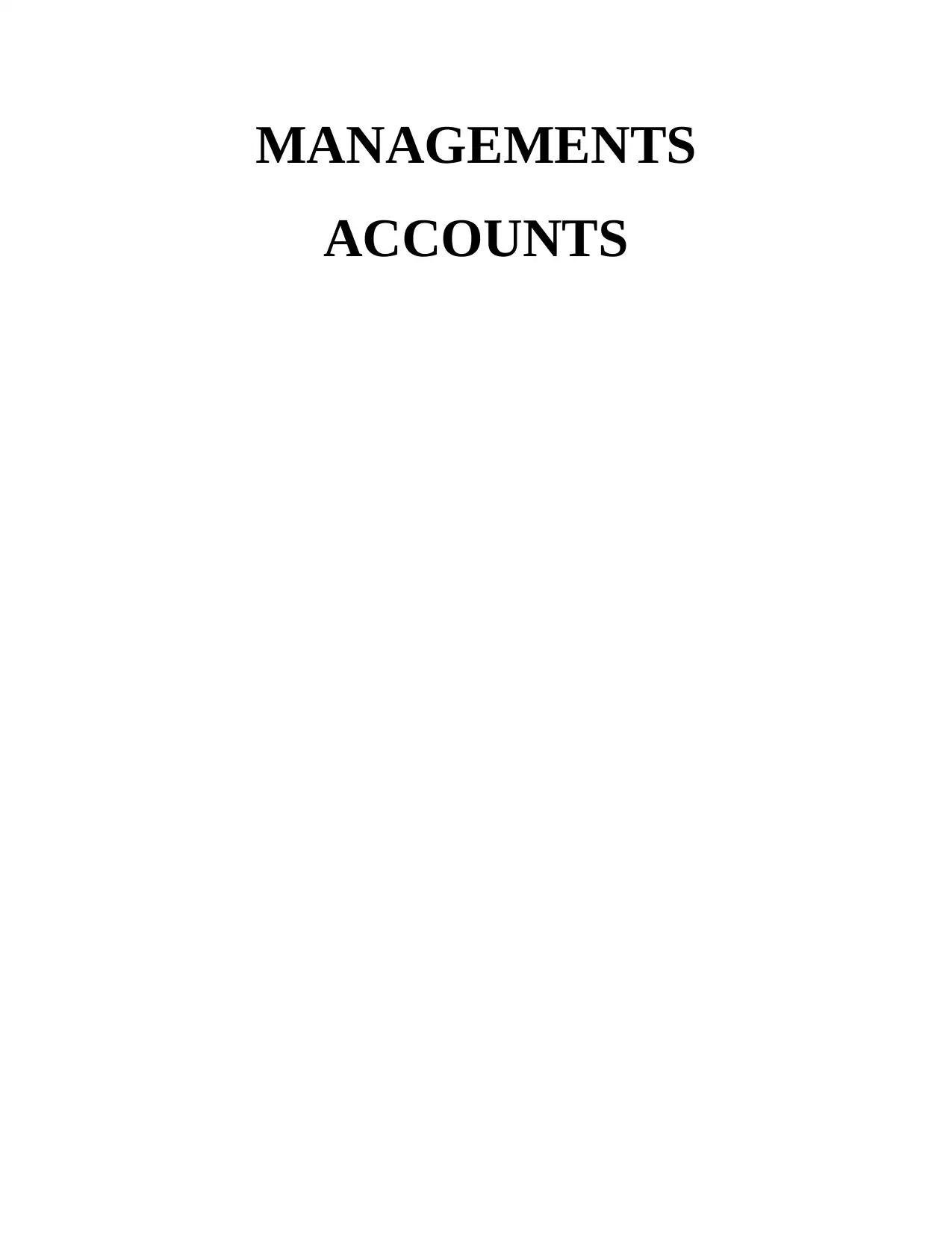
MANAGEMENTS
ACCOUNTS
ACCOUNTS
Paraphrase This Document
Need a fresh take? Get an instant paraphrase of this document with our AI Paraphraser
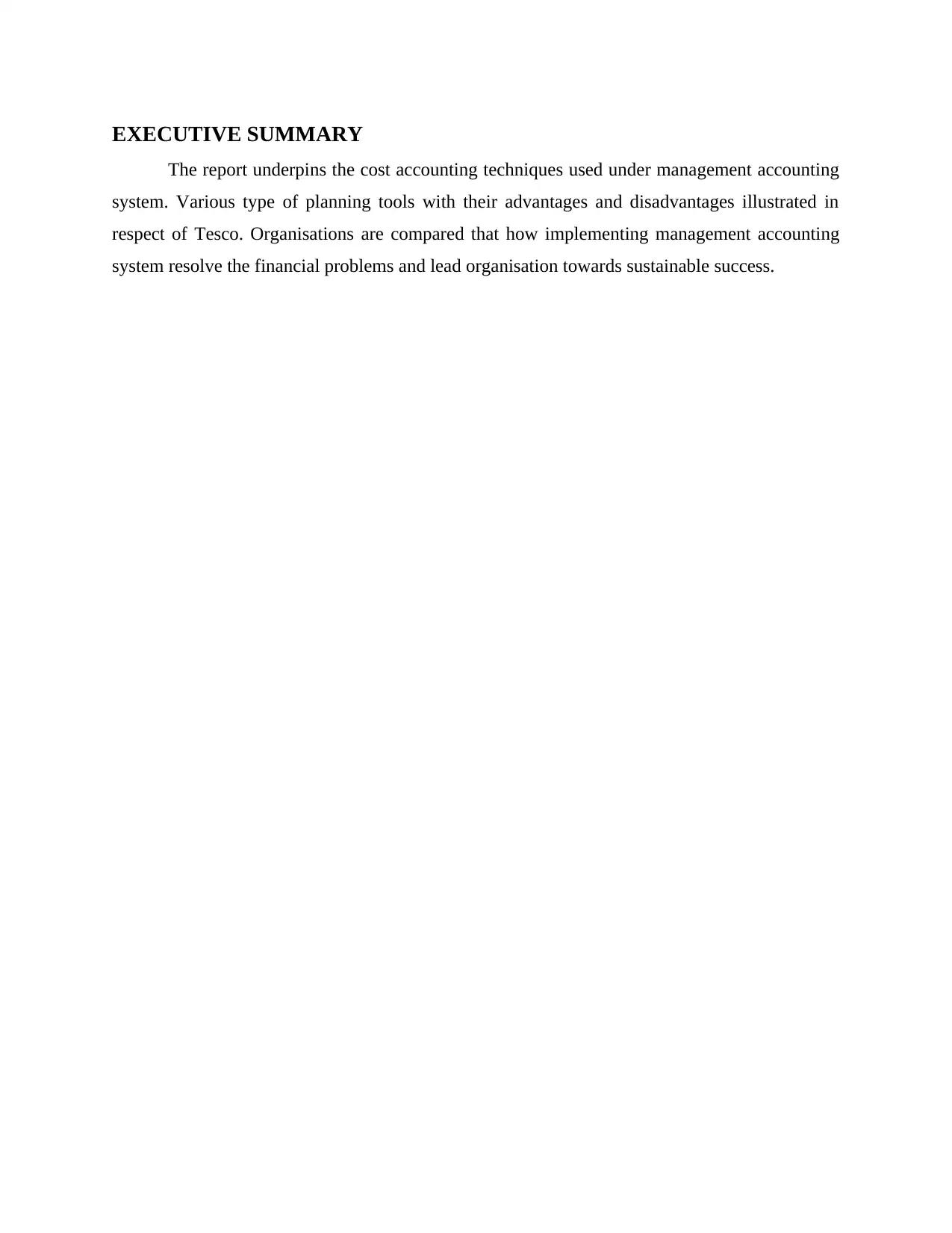
EXECUTIVE SUMMARY
The report underpins the cost accounting techniques used under management accounting
system. Various type of planning tools with their advantages and disadvantages illustrated in
respect of Tesco. Organisations are compared that how implementing management accounting
system resolve the financial problems and lead organisation towards sustainable success.
The report underpins the cost accounting techniques used under management accounting
system. Various type of planning tools with their advantages and disadvantages illustrated in
respect of Tesco. Organisations are compared that how implementing management accounting
system resolve the financial problems and lead organisation towards sustainable success.
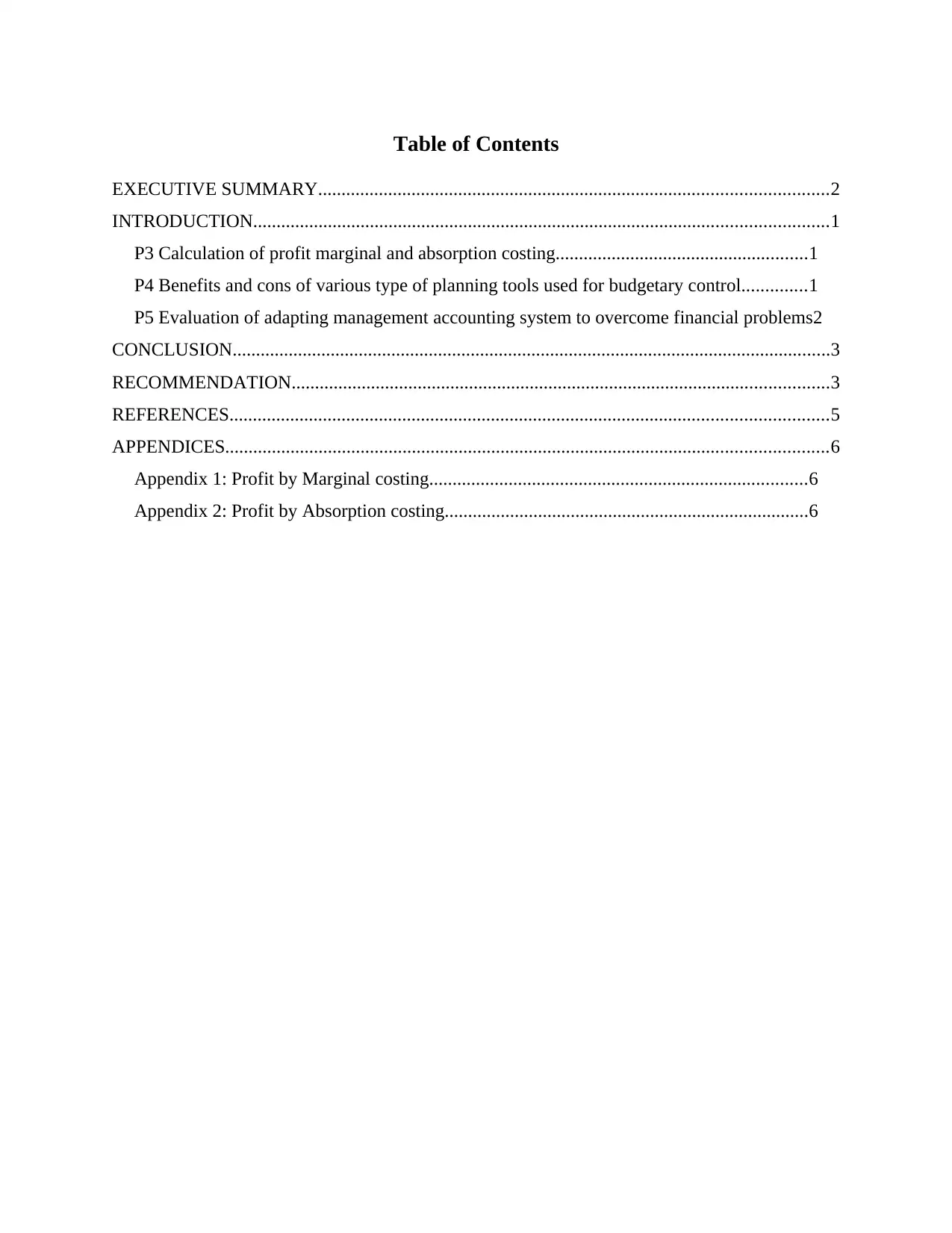
Table of Contents
EXECUTIVE SUMMARY.............................................................................................................2
INTRODUCTION...........................................................................................................................1
P3 Calculation of profit marginal and absorption costing......................................................1
P4 Benefits and cons of various type of planning tools used for budgetary control..............1
P5 Evaluation of adapting management accounting system to overcome financial problems2
CONCLUSION................................................................................................................................3
RECOMMENDATION...................................................................................................................3
REFERENCES................................................................................................................................5
APPENDICES.................................................................................................................................6
Appendix 1: Profit by Marginal costing.................................................................................6
Appendix 2: Profit by Absorption costing..............................................................................6
EXECUTIVE SUMMARY.............................................................................................................2
INTRODUCTION...........................................................................................................................1
P3 Calculation of profit marginal and absorption costing......................................................1
P4 Benefits and cons of various type of planning tools used for budgetary control..............1
P5 Evaluation of adapting management accounting system to overcome financial problems2
CONCLUSION................................................................................................................................3
RECOMMENDATION...................................................................................................................3
REFERENCES................................................................................................................................5
APPENDICES.................................................................................................................................6
Appendix 1: Profit by Marginal costing.................................................................................6
Appendix 2: Profit by Absorption costing..............................................................................6
⊘ This is a preview!⊘
Do you want full access?
Subscribe today to unlock all pages.

Trusted by 1+ million students worldwide

INTRODUCTION
Management accounting is recognised as accounting for managers in order to make
appropriate decisions and strategies. This report defines various type of costing techniques such
as marginal and absorption costing to evaluate profitability of organisation. Types of planning
tools that with advantages and disadvantages illustrated in this report to assist the budgetary
control process of Tesco. Comparing the ways to implement management accounting system in
organisation to overcome financial problems.
P3 Calculation of profit marginal and absorption costing
a) Average Production cost
Direct material + Direct labour + variable overheads + fixed variable overheads
Total production units
= 30000 + 20000 + 12000 + 10000 / 40000
= 72000 / 40000 = £1.8 per unit
Marginal cost = 30000 + 20000 + 12000 / 40000 = £1.55 per unit
b) Budgeted Trading account for the period
Refers to Appendices 1 and 2
c) It is evaluated that both the production project shows profits such as £185200 form marginal
costing and £161800 by absorption costing. So, Heinz should go with the production plan.
P4 Benefits and cons of various type of planning tools used for budgetary control
Various type of planning tools can be implemented by Tesco to analyse the budget for
better forecasting and decision making following are the planning tools defined in Tesco context
as follows;
Scenario tool: This tool helps in clarifying particular phenomenon regarding business
opportunities and aspected risk may happen in near future (SEAL and et al, 2014). This tool
helps to create separate image of future scenario that may impact upon business operations of
Tesco.
Advantages: It will be beneficial to absorb the management risk and
environmental effect for better communication scale.
Disadvantages: Main disadvantages of this tool is lack of relevancy and
management approach regarding the operational changes in Tesco.
1
Management accounting is recognised as accounting for managers in order to make
appropriate decisions and strategies. This report defines various type of costing techniques such
as marginal and absorption costing to evaluate profitability of organisation. Types of planning
tools that with advantages and disadvantages illustrated in this report to assist the budgetary
control process of Tesco. Comparing the ways to implement management accounting system in
organisation to overcome financial problems.
P3 Calculation of profit marginal and absorption costing
a) Average Production cost
Direct material + Direct labour + variable overheads + fixed variable overheads
Total production units
= 30000 + 20000 + 12000 + 10000 / 40000
= 72000 / 40000 = £1.8 per unit
Marginal cost = 30000 + 20000 + 12000 / 40000 = £1.55 per unit
b) Budgeted Trading account for the period
Refers to Appendices 1 and 2
c) It is evaluated that both the production project shows profits such as £185200 form marginal
costing and £161800 by absorption costing. So, Heinz should go with the production plan.
P4 Benefits and cons of various type of planning tools used for budgetary control
Various type of planning tools can be implemented by Tesco to analyse the budget for
better forecasting and decision making following are the planning tools defined in Tesco context
as follows;
Scenario tool: This tool helps in clarifying particular phenomenon regarding business
opportunities and aspected risk may happen in near future (SEAL and et al, 2014). This tool
helps to create separate image of future scenario that may impact upon business operations of
Tesco.
Advantages: It will be beneficial to absorb the management risk and
environmental effect for better communication scale.
Disadvantages: Main disadvantages of this tool is lack of relevancy and
management approach regarding the operational changes in Tesco.
1
Paraphrase This Document
Need a fresh take? Get an instant paraphrase of this document with our AI Paraphraser

Contingency tool: This tool mainly helps to resolve the unconditional scenarios and
problems of business in a particular time duration (Yeshmin and Hossan, 2011). There is one of
the main aspect helps in determining the uncertain calms managed by management committee of
Tesco.
Advantages: This tool is effective in terms of allowing the business ideas to
convert them in real scenario.
Disadvantages: Sometimes bulk of services and context remain avoided that
reduce the burden of different organisational structure. Management of Tesco may faces the
complexity to use this tool in organisational context.
Forecasting tool: This tool helps to making budgets, analysing the projected scenarios
and requirements of business for further use (van der Steen, 2011). Tesco can implement this
system to forecast the future cost, growth and trend analysis.
Advantages: A pre determination of expected cost to be incurred and expected revenue
to be generated in future helps to make budgets appropriately in Tesco.
Disadvantages: This approach do not remain centralised around providing exact results
and figures due to uncertainties.
P5 Evaluation of adapting management accounting system to overcome financial problems
Financial problems and challenges are the part of business operations. Tesco is one of the
multinational retail industry in the UK. There is a challenge regarding managing the financial
resources to manage the stores department in Tesco. Managers are seeking for better financial
management tool to overcome this financial issue. There are two financial problem analytical
tools can be implemented by organisation such as;
Benchmarking: This tool helps to evaluate the business performance with its past
benchmarks and standards. If current level of executions remains less than potential areas of
requirement find out that mainly remain associated with financial issues. It will help Tesco to
understand its ideal stores managing orders to control the carting cost with in organisation.
KPI: Key performance indicators is a bifurcated financial problem analysis tool. It
mainly consider two major aspects regarding analysing the financial problems such as Financial
KPI and Non financial KPI (Yalcin, 2012). Tesco will be able to consolidate the problems by
evaluating the financial KPI s through ratio analysis.
2
problems of business in a particular time duration (Yeshmin and Hossan, 2011). There is one of
the main aspect helps in determining the uncertain calms managed by management committee of
Tesco.
Advantages: This tool is effective in terms of allowing the business ideas to
convert them in real scenario.
Disadvantages: Sometimes bulk of services and context remain avoided that
reduce the burden of different organisational structure. Management of Tesco may faces the
complexity to use this tool in organisational context.
Forecasting tool: This tool helps to making budgets, analysing the projected scenarios
and requirements of business for further use (van der Steen, 2011). Tesco can implement this
system to forecast the future cost, growth and trend analysis.
Advantages: A pre determination of expected cost to be incurred and expected revenue
to be generated in future helps to make budgets appropriately in Tesco.
Disadvantages: This approach do not remain centralised around providing exact results
and figures due to uncertainties.
P5 Evaluation of adapting management accounting system to overcome financial problems
Financial problems and challenges are the part of business operations. Tesco is one of the
multinational retail industry in the UK. There is a challenge regarding managing the financial
resources to manage the stores department in Tesco. Managers are seeking for better financial
management tool to overcome this financial issue. There are two financial problem analytical
tools can be implemented by organisation such as;
Benchmarking: This tool helps to evaluate the business performance with its past
benchmarks and standards. If current level of executions remains less than potential areas of
requirement find out that mainly remain associated with financial issues. It will help Tesco to
understand its ideal stores managing orders to control the carting cost with in organisation.
KPI: Key performance indicators is a bifurcated financial problem analysis tool. It
mainly consider two major aspects regarding analysing the financial problems such as Financial
KPI and Non financial KPI (Yalcin, 2012). Tesco will be able to consolidate the problems by
evaluating the financial KPI s through ratio analysis.
2

Financial governance: It is an regulatory that helps to manage the accounting principle and
techniques to correlate the financial problems of organisation (Wouters and Kirchberger, 2015).
As the the financial governance will help to manage the orders of stores in Tesco to overcome
the financial cost of organisation.
Comparison between organisation to resolve financial problems to overcome financial
challenges
Tesco Walmart
KPI is used by Tesco to analyse the financial
issue. In managers find that controlling the
stores order that enhanced the cost of stores
department is the major financial issue to
control the departmental cost.
Walmart faced an issue regarding bottom line
stock that resulted decreased in overall
revenues and less sales comparatively to last
year. Company implemented Benchmarking to
analyse this financial issue by evaluating its
past performance and compare with its current
financial position.
Job costing manageable accounting system is
implemented by managers to resolve the
financial issues. Which will help to resolve the
problem of resolving the departmental cost.
Inventory management system adapted by
management of Walmart to control the excess
cost of business and increase the profitability
of organisation for sustainable success and
development.
CONCLUSION
The report summarise the misconception of management accounting system in
organisational context. It is recognised that various type of management accounting system are
helpful according to different nature and type of organisations. Accounting reports summarise
the information in more contingent way and assist decision making process. It is explicated that
various planning tools helps in budgetary control process. In the end, it is summarised that
organisations are adapting management accounting system to overcome financial problems such
as carting cost, storage cost.
3
techniques to correlate the financial problems of organisation (Wouters and Kirchberger, 2015).
As the the financial governance will help to manage the orders of stores in Tesco to overcome
the financial cost of organisation.
Comparison between organisation to resolve financial problems to overcome financial
challenges
Tesco Walmart
KPI is used by Tesco to analyse the financial
issue. In managers find that controlling the
stores order that enhanced the cost of stores
department is the major financial issue to
control the departmental cost.
Walmart faced an issue regarding bottom line
stock that resulted decreased in overall
revenues and less sales comparatively to last
year. Company implemented Benchmarking to
analyse this financial issue by evaluating its
past performance and compare with its current
financial position.
Job costing manageable accounting system is
implemented by managers to resolve the
financial issues. Which will help to resolve the
problem of resolving the departmental cost.
Inventory management system adapted by
management of Walmart to control the excess
cost of business and increase the profitability
of organisation for sustainable success and
development.
CONCLUSION
The report summarise the misconception of management accounting system in
organisational context. It is recognised that various type of management accounting system are
helpful according to different nature and type of organisations. Accounting reports summarise
the information in more contingent way and assist decision making process. It is explicated that
various planning tools helps in budgetary control process. In the end, it is summarised that
organisations are adapting management accounting system to overcome financial problems such
as carting cost, storage cost.
3
⊘ This is a preview!⊘
Do you want full access?
Subscribe today to unlock all pages.

Trusted by 1+ million students worldwide
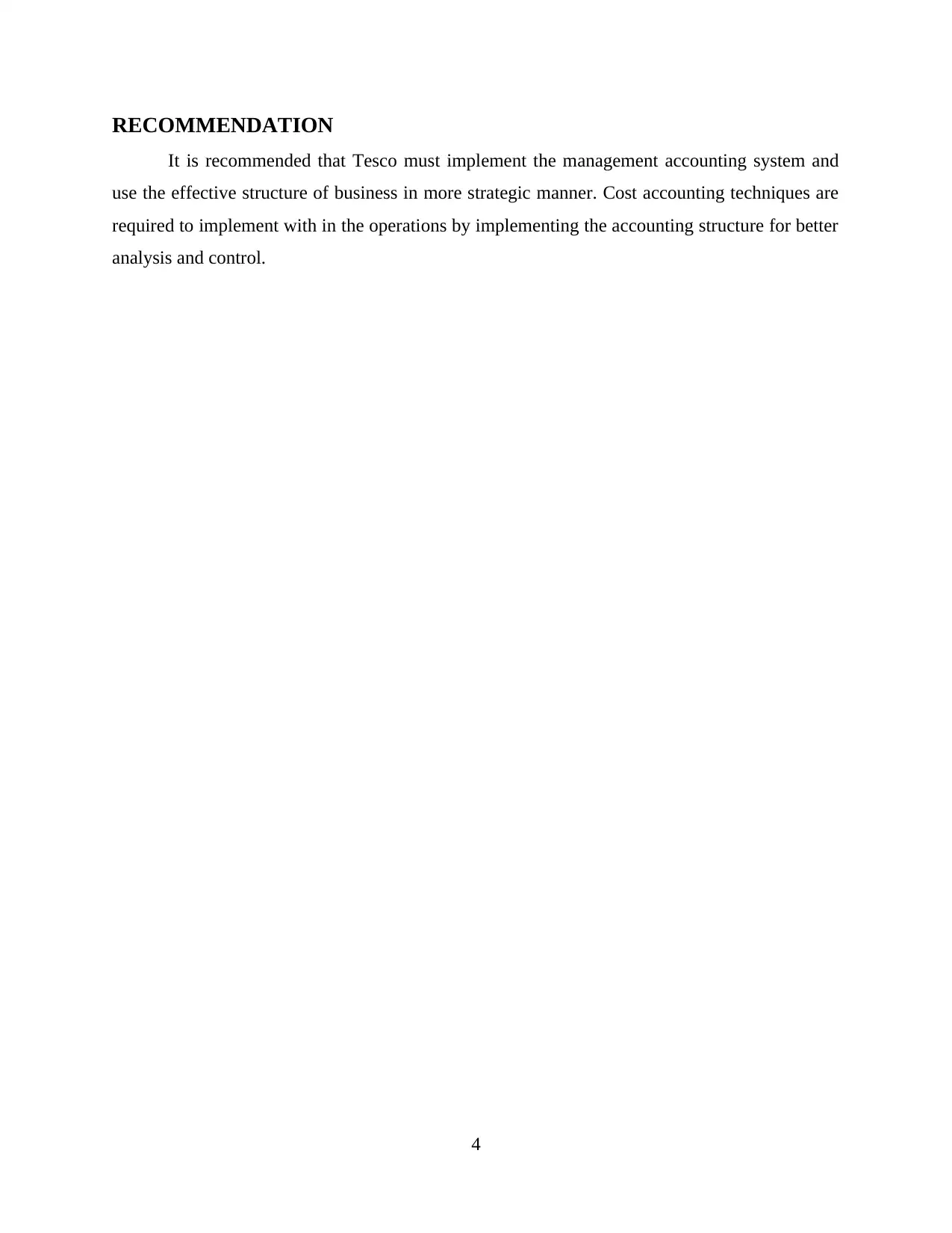
RECOMMENDATION
It is recommended that Tesco must implement the management accounting system and
use the effective structure of business in more strategic manner. Cost accounting techniques are
required to implement with in the operations by implementing the accounting structure for better
analysis and control.
4
It is recommended that Tesco must implement the management accounting system and
use the effective structure of business in more strategic manner. Cost accounting techniques are
required to implement with in the operations by implementing the accounting structure for better
analysis and control.
4
Paraphrase This Document
Need a fresh take? Get an instant paraphrase of this document with our AI Paraphraser
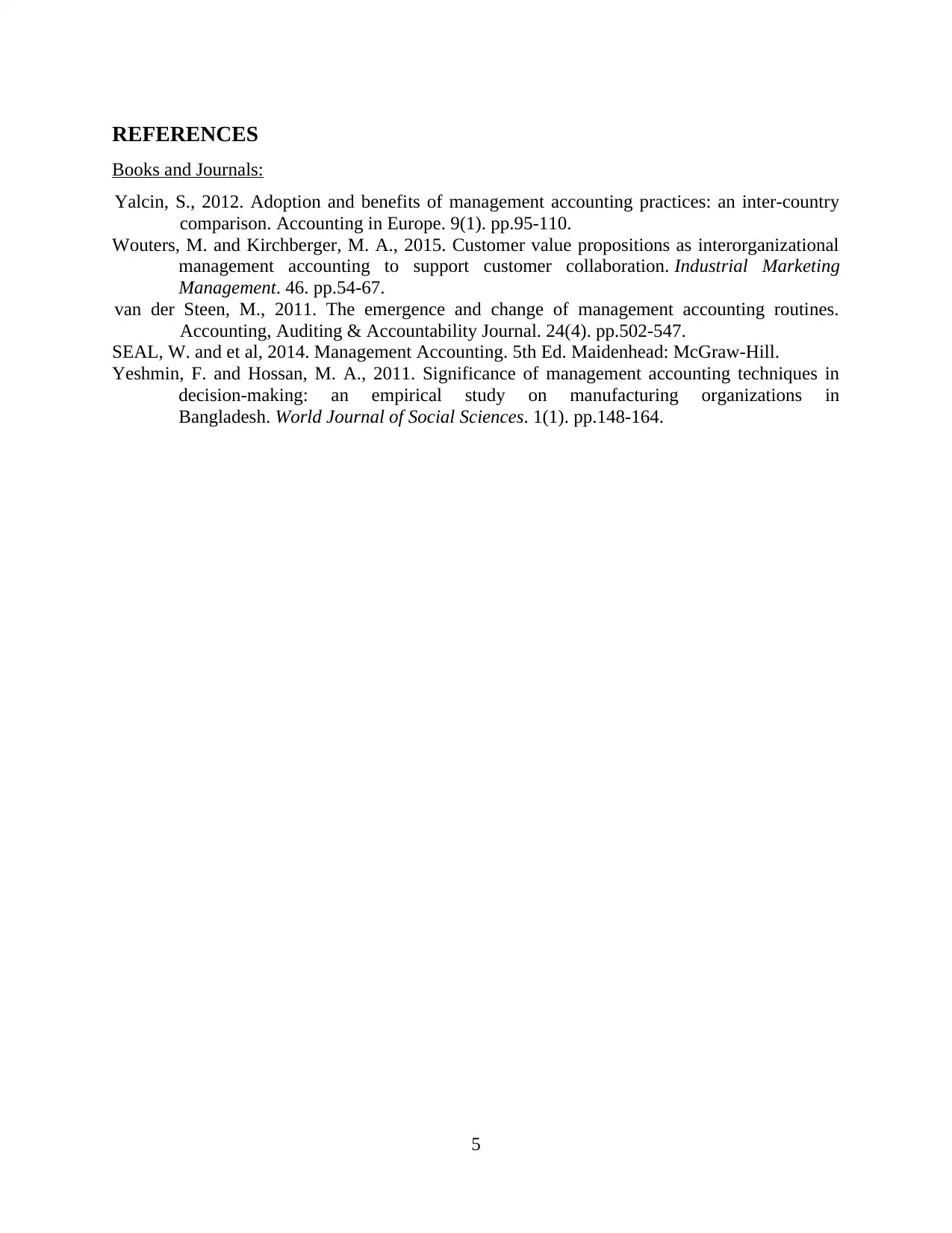
REFERENCES
Books and Journals:
Yalcin, S., 2012. Adoption and benefits of management accounting practices: an inter-country
comparison. Accounting in Europe. 9(1). pp.95-110.
Wouters, M. and Kirchberger, M. A., 2015. Customer value propositions as interorganizational
management accounting to support customer collaboration. Industrial Marketing
Management. 46. pp.54-67.
van der Steen, M., 2011. The emergence and change of management accounting routines.
Accounting, Auditing & Accountability Journal. 24(4). pp.502-547.
SEAL, W. and et al, 2014. Management Accounting. 5th Ed. Maidenhead: McGraw-Hill.
Yeshmin, F. and Hossan, M. A., 2011. Significance of management accounting techniques in
decision-making: an empirical study on manufacturing organizations in
Bangladesh. World Journal of Social Sciences. 1(1). pp.148-164.
5
Books and Journals:
Yalcin, S., 2012. Adoption and benefits of management accounting practices: an inter-country
comparison. Accounting in Europe. 9(1). pp.95-110.
Wouters, M. and Kirchberger, M. A., 2015. Customer value propositions as interorganizational
management accounting to support customer collaboration. Industrial Marketing
Management. 46. pp.54-67.
van der Steen, M., 2011. The emergence and change of management accounting routines.
Accounting, Auditing & Accountability Journal. 24(4). pp.502-547.
SEAL, W. and et al, 2014. Management Accounting. 5th Ed. Maidenhead: McGraw-Hill.
Yeshmin, F. and Hossan, M. A., 2011. Significance of management accounting techniques in
decision-making: an empirical study on manufacturing organizations in
Bangladesh. World Journal of Social Sciences. 1(1). pp.148-164.
5
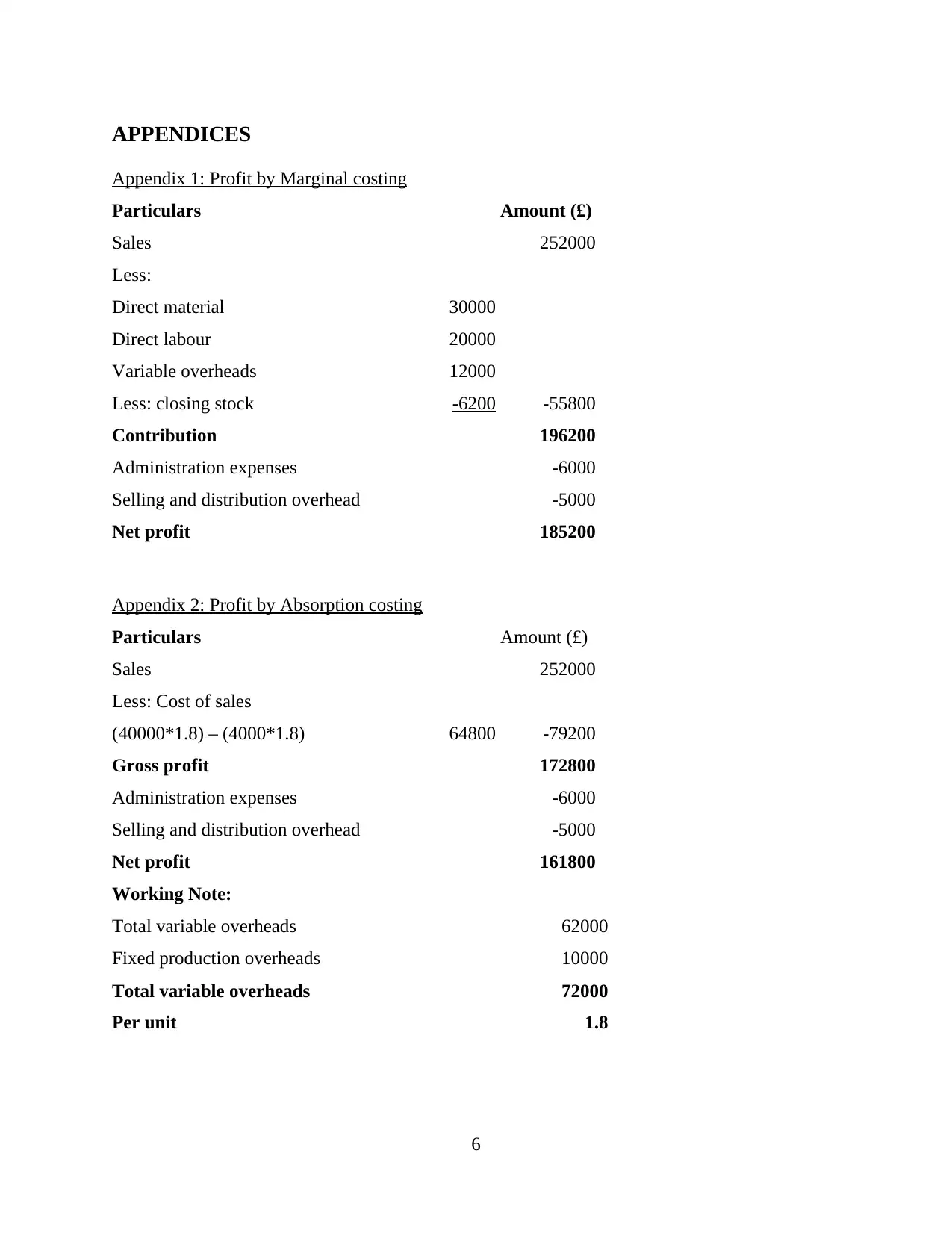
APPENDICES
Appendix 1: Profit by Marginal costing
Particulars Amount (£)
Sales 252000
Less:
Direct material 30000
Direct labour 20000
Variable overheads 12000
Less: closing stock -6200 -55800
Contribution 196200
Administration expenses -6000
Selling and distribution overhead -5000
Net profit 185200
Appendix 2: Profit by Absorption costing
Particulars Amount (£)
Sales 252000
Less: Cost of sales
(40000*1.8) – (4000*1.8) 64800 -79200
Gross profit 172800
Administration expenses -6000
Selling and distribution overhead -5000
Net profit 161800
Working Note:
Total variable overheads 62000
Fixed production overheads 10000
Total variable overheads 72000
Per unit 1.8
6
Appendix 1: Profit by Marginal costing
Particulars Amount (£)
Sales 252000
Less:
Direct material 30000
Direct labour 20000
Variable overheads 12000
Less: closing stock -6200 -55800
Contribution 196200
Administration expenses -6000
Selling and distribution overhead -5000
Net profit 185200
Appendix 2: Profit by Absorption costing
Particulars Amount (£)
Sales 252000
Less: Cost of sales
(40000*1.8) – (4000*1.8) 64800 -79200
Gross profit 172800
Administration expenses -6000
Selling and distribution overhead -5000
Net profit 161800
Working Note:
Total variable overheads 62000
Fixed production overheads 10000
Total variable overheads 72000
Per unit 1.8
6
⊘ This is a preview!⊘
Do you want full access?
Subscribe today to unlock all pages.

Trusted by 1+ million students worldwide
1 out of 9
Related Documents
Your All-in-One AI-Powered Toolkit for Academic Success.
+13062052269
info@desklib.com
Available 24*7 on WhatsApp / Email
![[object Object]](/_next/static/media/star-bottom.7253800d.svg)
Unlock your academic potential
Copyright © 2020–2025 A2Z Services. All Rights Reserved. Developed and managed by ZUCOL.





